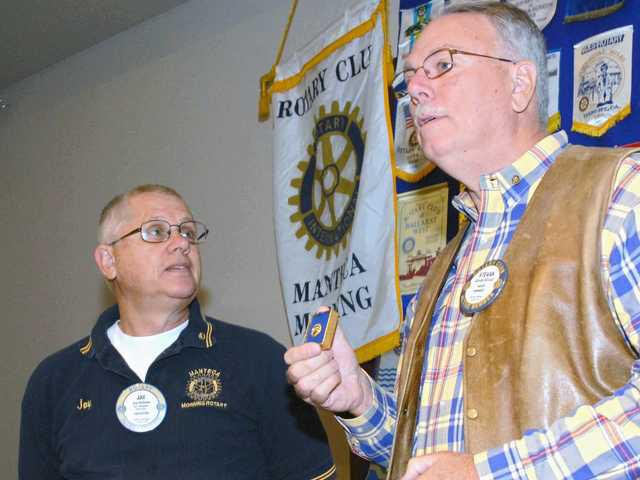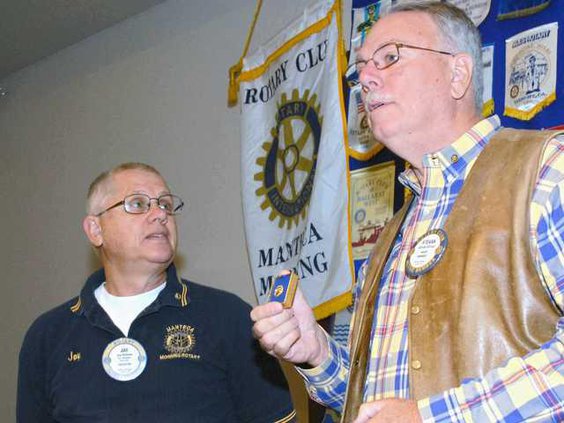Jay Holmes – a retired principal of a California Youth Authority school for boys – holds court every Tuesday as president of the Manteca Morning Rotary Club that meets at the Doctors Hospital conference center.
It’s a time of the day the club meets that seems to draw type “A” personalities who have little trouble getting up to attend the 6:45 a.m. meeting. Their numbers are small but they have proven their might through their accomplishments over the years.
Manteca dentist John Trueb religiously makes the teenage Rotary Interact meetings to show his support for the younger club’s efforts in cleaning up the roadway of trash along Highway 120.
Holmes opens his meetings with his banjo in hand asking club members to stand and join in one of the old favorites that he draws from a song list that is followed by breakfast from the hospital cafeteria. Of course there’s always the “bad joke of the day” that brings with it a fine that finds its way into the Rotary Foundation – when the joke is a total flop it may cost the contributor more in greenbacks.
I had always thought the early time of the meetings would inhibit speakers, but the club has had some good programs. They always welcome visitors to join them and share scrambled eggs, fruit, toast and coffee.
The club members expect to be on their way out the door by 8 a.m. but they always have time for their weekly programs – and they have had some good ones at that.
Included in recent months have been Dave Mantooth from the district attorney’s office, oral surgeon Abishek Mogre, Jim Dorroh of First Service Technology, Chris Clark of Advance Economics Academy, Deli House owner Eddie Harro, Cheryl Martin of Merrill Gardens, David Saenz of Advance Transmission, and Russell Rottacker of Manteca, practicing Chiropractic Neurology at his Cherry Avenue location.
Rottacker shares in & outs of his chiropractic career
Dr. Rottacker told the group he had been a chiropractor since 1983. Growing up as a kid in the Midwest he had made a decision to get involved in the health care field and hoped he could someday move west.
During his senior year in high school he “did goofy things” and took his body water skiing, ending up with a pretty good whiplash to his neck, he said. After trying different types of treatment he found chiropractic to be very effective which took him from a planned major in medicine to chiropractic with an eventual more in-depth neurological approach to treating his patients beyond chiropractic.
Graduating from a chiropractic school in 1983 in Davenport, IA, he started his practice in Colorado to get away from the heat of Iowa. He said when he graduated from college it was June and he couldn’t take the California board until November.
“I had a wife and two kids – I had to get to work to support my family,” he remembered. “I was able to take the Colorado board two weeks after I graduated and two weeks later I had a Colorado license in my hand – first practicing in Monte Vista in the southern end of the state – cold as blazes.”
Rottacker joked as he remembered the last snow of the season was on Easter.
“Try hiding Easter eggs in the snow,” he laughed. “It’s boom, boom, boom and they’re gone.”
He said he eventually passed the California boards and took his family to Modesto. He practiced in Modesto for three years. Looking for a larger practice he moved on to San Francisco where he worked for 17 years in a multi-doctor facility, training other doctors who were coming into the chiropractic firm.
“On our own we had a multiple-discipline practice,” he added. “At one point we had 7,500 square feet with nine associates, three massage therapists and a neurologist who came in once a month, a podiatrist and a staff of 28”. He did that for about three years “until we decided to take the practice in a different direction.”
He said early in 2005, when the real estate market was at its best, Rottacker said he decided it was time to sell and to move. He relocated to Manteca in 2005 mainly because he had family in San Joaquin County – his parents and four sisters.
The doctor said he isn’t doing the traditional chiropractic model any longer, saying he needed to improve on his skills because he wasn’t having the enjoyment of the practice. Rottacker went back to school and did a three year post graduate discipline in Neurology.
Functional Neurology, as it is referred to, doesn’t make use of medications, drugs, or surgery, he explained, but makes a doctor able to improve someone’s functional capacity. He said he found new skills that draw from medicine, that draw from neurology and other different fields.
“With the skill set I have at this point, I am able to work with patients who have had strokes, brain injuries and spinal cord injuries and kids with ADHD and actually do something effective,” he said.
As an example he said he had a young 15-year-old girl come in recently who had been riding with a friend behind a tow boat that went over a rough patch of water and the friend was thrown and the two bumped heads together.
He said she the injured teen was dragged back into the boat and eventually placed sitting on the bank for a couple of hours where she continued to throw up as she was suffering from a concussion. The greater problem was that she couldn’t see. She was a high school student who was getting straight As in school and had plans to become a veterinarian, he recalled.
After a CT Scan and various other assessments with an eventual diagnosis of hysterical blindness she was told there was nothing wrong with her and that she was just faking it. They released her saying medics couldn’t do anything for her.
He explained that the girl’s vision partially came back but she could only see something the size of a quarter directly in front of each eye – and that was it. For the next month she was taken back to that health care organization on four different occasions with change, Rottacker added.
The Manteca doctor took over her care doing an assessment on his new patient and found that a particular portion of her central nervous system in the cortex of her brain was not working correctly. His treatment methodology was actually using a pair of glasses with little tiny lights that shine inward toward the eyes that could be programmed to flash.
He noted that the lights flash for about two to three seconds and then they turn off for a 10 to 15 second interval and then they flash again with variations to affect both sides of the brain that eventually improved her total peripheral vision reversing some of the adverse damage from the concussion. The girl had to make use of the glasses five times a day plus taking nutritional support to calm down the inflammatory response to her brain caused by the blow to her head.
“When your brain is concussed it’s just like smashing your finger in a door,” he said. “It’s swollen, angry and complaining.”
He added that damage to the central nervous system often does not result in physical damage other than part of the brain just shutting off. It’s sometimes like a computer that has to be rebooted, he said.
“Within two weeks her peripheral vision was out to an 18-inch sphere and by another two weeks it was out even further and after another two weeks she had full recovery,” he said.





